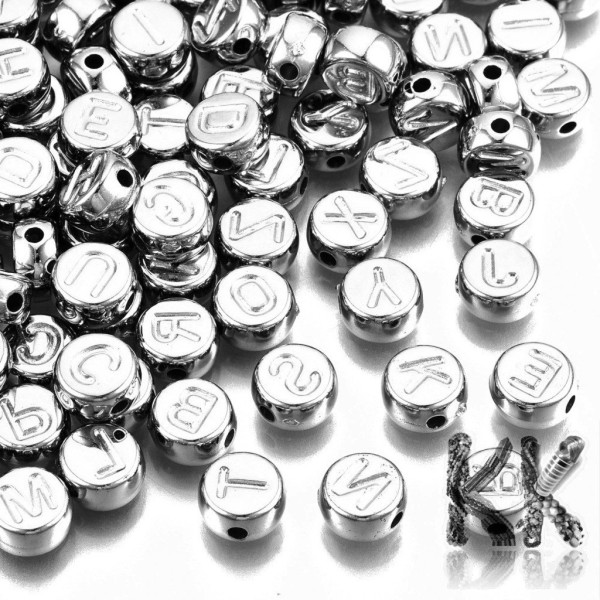CCB Acrylic Beads with letters - Platinum Color Plated mix of Lentils - Ø 7 x 4 mm - 50 g (approx. 320 pcs)
Beads with letters made of acrylic material with a diameter of 7 mm, a height of 4 mm and a hole for a thread with a diameter of 1.4 mm. The beads have the shape of lentils, engraved text on a platinum base and are sold in a random mix of letters by 50 grams (approx. 320 pcs). The beads are plated with high-quality long-lasting CCB plating (so-called Copper Coated Beads technology), where the plastic surface is firstly plated with copper, which adheres well to the plastic surface and the copper is then plated with another metallic paint, which blends very well with the metallic copper surface. Thanks to this, the beads are very high quality and very durable.
THE PRICE IS FOR 50 g (approx. 320 pcs).
Beads with letters made of acrylic material with a diameter of 7 mm, a height of 4 mm and a hole for a thread with a diameter of 1.4 mm. The beads have the shape of lentils, engraved text on a platinum base and are sold in a random mix of letters by 50 grams (approx. 320 pcs). The beads are plated with high-quality long-lasting CCB plating (so-called Copper Coated Beads technology), where the plastic surface is firstly plated with copper, which adheres well to the plastic surface and the copper is then plated with another metallic paint, which blends very well with the metallic copper surface. Thanks to this, the beads are very high quality and very durable.
Due to the color setting of the monitor, the color of the goods may differ slightly from reality.
Data sheet
- Material
- Plastic
- Shape
- Flat round
.
How to identify dyed minerals, artificial minerals and imitations? Simple hammer test can do the trick..
-
How to choose correctly?
-
What is the difference between waxing, dyeing, heating?
-
Why do beads fade?
-
Is there anything I can do against it?
-
Hammer tests for Jade, Agate, Malachite, Opalite, Azurite, Turquoise, Tyrkenite, Larimar, Hematite and Coral
-
When buying beads, why are there different color qualities from the same mineral on the same string?
.
A series of videos to help you navigate your bead selection. Watch the hammer tests where we show the differences in real minerals, synthetic substitutes and plastic imitation minerals. Fortunately, we have everything clearly marked on the Katlas Beads store, we never lie. This is a certainty which is hard to find on other e-shops.
From time to time, we come across someone complaining that they ordered a mineral in a certain colour and that some minerals have a slightly different shade or spots., how do we navigate the selection process? You need to understand that raw minerals are never identical. And it's proof that it's not an imitation or synthetic. On the Katlas beads eshop, you will come across multiple grades of qualities that address these queries.
After watching the videos, you will have accurate information and be able to navigate all the e-stores selling mineral beads.
Don't forget to subscribe to our YouTube channel. You won't miss any important videos and expert advice that will make you an expert in beading.
.

















